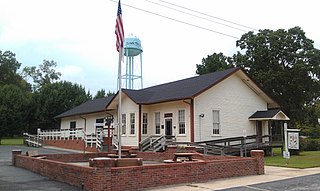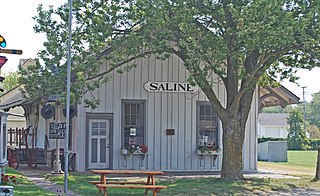
Netherwood is a New Jersey Transit railroad station on the Raritan Valley Line, in Plainfield, Union County, New Jersey, United States. It is located along North Avenue at the intersection of Netherwood Avenue and along South Avenue at the intersection of Belvedere Avenue. The station has a ticket vending machine, and the station house itself is located off of South Avenue.

Hamlet station is an Amtrak train station in Hamlet, North Carolina, United States. The station is located within the Main Street Commercial Historic District and is in walking distance to the National Railroad Museum and Hall of Fame.

The Atchison, Topeka and Santa Fe Passenger and Freight Complex is a nationally recognized historic district located in Fort Madison, Iowa, United States. It was listed on the National Register of Historic Places in 1992. At the time of its nomination it contained three resources, all of which are contributing buildings. The buildings were constructed over a 24-year time period, and reflect the styles that were popular when they were built. The facility currently houses a local history museum, and after renovations a portion of it was converted back to a passenger train depot for Amtrak, which opened on December 15, 2021.

The Apex Union Depot is a historic railroad station located on Salem Street in downtown Apex, North Carolina and is the centerpiece of the Apex Historic District. Constructed in 1914 by the Seaboard Air Line Railroad, the building shared service with the Durham and Southern Railway, but now houses the Apex Visitor's Center, Apex Chamber of Commerce, and meeting rooms rented out for special events. A 37-foot Louisville and Nashville Railroad caboose is located beside the building. In December 1998 the Apex Union Depot was listed on the National Register of Historic Places.

The Quakertown Passenger and Freight Station is a historic train station and freight depot located at Quakertown, Bucks County, Pennsylvania. The two buildings were designed by Wilson Bros. & Company in 1889 and built by Cramp and Co. for the Philadelphia and Reading Railroad in 1902. The passenger station is constructed of dark Rockhill granite and Indiana limestone and is in a Late Victorian style. It is 1+1⁄2 stories tall and measures 25 feet wide by 97 feet 6 inches, long. It has a hipped roof with an eight-foot overhang. The freight station is a 1+1⁄2-story, rectangular stone block building measuring 128 by 30 feet. Also on the property is a large crane that was used for freight movement. The Quakertown station had passenger rail service along the Bethlehem Line to Bethlehem and Philadelphia until July 27, 1981, when SEPTA ended service on all its intercity diesel-powered lines. SEPTA still owns the line and leases it to the East Penn Railroad. Other towns, stations, and landmarks on the Bethlehem Line are Perkasie, Pennsylvania, Perkasie Tunnel, and Perkasie station.

Marlinton Chesapeake and Ohio Railroad Station was a historic railway station and bunkhouse located at Marlinton, Pocahontas County, West Virginia. They were built in 1901 by the Chesapeake and Ohio Railroad. The station was a frame, rectangular, one-story building measuring 76 feet by 16 feet and used for both passengers and freight. The bunkhouse is a one-story frame building measuring 24 feet by 16 feet. Both buildings featured vertical board and batten siding and decorative brackets in the wide projecting eaves of their gable roofs. Passenger service ended at Marlinton in 1958. Given its location at the trailhead of the Greenbrier River Trail, the station was renovated to house the Pocahontas County Convention and Visitors Bureau. The station was destroyed by fire in 2008; the bunkhouse remains extant.

Connellsville Union Passenger Depot, also known as the Connellsville Pittsburgh & Lake Erie Station, is a historic railway station located at Connellsville, Fayette County, Pennsylvania. It was built between 1911 and 1912 by the Pittsburgh and Lake Erie Railroad and Western Maryland Railway. It is a 1 1/2-story, rectangular brick building measuring 109 feet by 28 feet. It features a three-story tower, wide overhanging eaves, and hipped roofs on the building and tower covered in blue-green Spanish terra cotta tiles. It is in an American Craftsman style of architecture. It ceased use as a passenger station in 1939, after which it housed a car dealership and auto parts store. It was purchased by the Youghiogheny Opalescent Glass Company in the spring of 1995.

The Nevada–California–Oregon Railway Passenger Station is a historic train station in Lakeview, Oregon, United States. It was built in 1912 by contractor I. A. Underwood from plans by architect Frederic DeLongchamps. It was the northern terminus of the Nevada–California–Oregon Railway. The Southern Pacific Railroad company owned and operated the depot from 1928 until 1975, when it was closed. Since 1978, the building has been used as a law office and later a private residence. Because of its importance to local history, the depot was listed on the National Register of Historic Places in 1983.

The Thomasville Railroad Passenger Depot is a historic train station located at Thomasville, Davidson County, North Carolina. It is one of the oldest remaining frame depots in the state, built between 1870 and 1871. The board-and-batten building features Victorian sawnwork detailing. Until 1912, it served as a passenger train station with the Richmond and Danville Railroad and later the Southern Railway. Due to the increase in passenger rail travel, a new brick depot was built. This depot was then moved to the north side of the tracks and served as a freight agent's office. The Southern Railway eventually gave the structure to the town. The Thomasville Historical Society raised $5,000 for its restoration in 1969. Another restoration was completed in the late 1990s. In July 2000, the Thomasville Railroad Passenger Depot became the home of the Thomasville Visitors' Center.

Chelsea station is a disused railroad depot located at 150 Jackson Street in Chelsea, Michigan. It was designated a Michigan State Historic Site in 1986 and listed on the National Register of Historic Places in 2010 as Michigan Central Railroad Chelsea Depot. The depot is the only known Michigan example designed by the well known Detroit architectural firm of Mason and Rice.

The Contoocook Railroad Depot is located in Hopkinton, New Hampshire, United States, in the village of Contoocook. The depot was completed in 1849 as one of the first substantial railroad passenger stations west of Concord on the Concord and Claremont Railroad. The building is one of the best preserved of a small number of gable-roofed railroad stations surviving from the first decade of rail development in New Hampshire. The station exemplifies the pioneering period of rail development in the state.

The Sandown Depot is a former railroad station of the Boston and Maine Railroad in Sandown, New Hampshire. Built in 1873–74, it is the best-preserved of stations built by the Nashua and Rochester Railroad to survive, remaining relatively unaltered since its construction, and still at its original location. It is now a local history museum, and was listed on the National Register of Historic Places in 1986, and the New Hampshire State Register of Historic Places in 2011.

Clarkton Depot is a historic train station located at Clarkton, Bladen County, North Carolina. It was built as a passenger and freight station by the Seaboard Air Line Railroad in 1915. It is a one-story, rectangular frame building measuring 30 feet by 90 feet. The station served the SAL's daily passenger train from Wilmington to its Charlotte station in Charlotte via Hamlet and Monroe.

Rural Hall Depot is a historic train station located at Rural Hall, Forsyth County, North Carolina. It was built in 1888 for the Cape Fear and Yadkin Valley Railway. It is a one-story rectangular frame building sheathed in German siding. It measures 23 feet wide and 78 feet long. The interior consists of waiting rooms for white and "colored" passengers and a station master's office. Passenger service ceased in 1955, but the depot continued to provide services and facilities to freight trains until its closing in 1980. The building was moved to its present site in March 1980, and serves as a local railroad museum.

Franklinton Depot, also known as the Raleigh and Gaston Railroad Passenger Depot and Franklinton Woman's Club Clubhouse, is a historic train station located at 201 East Mason Street in Franklinton, Franklin County, North Carolina. It was built by the Raleigh and Gaston Railroad in 1886, and is a one-story, rectangular frame building with Italianate, Queen Anne, and Gothic Revival style design elements. The main section measures 51 feet by 16 feet, with an attached 10 feet by 12 feet baggage room. The main section has a steeply pitched gable roof and baggage room a low-pitched hip roof. It served the Seaboard Air Line's Palmland as well as local service between Norlina and Hamlet.

Norfolk Southern Passenger Station is a historic train station located at Elizabeth City, Pasquotank County, North Carolina. It was built in 1914 by the Norfolk Southern Railway, and is a long one-story brick building with eclectic Mission Revival style design elements. It measures 98 feet by 36 feet, with a small projecting control booth. It is topped by a tall hipped roof sheathed in clay tile. Passenger service at Elizabeth City ceased in early 1948, and the building subsequently housed a variety of commercial businesses.

Burgaw Depot is a historic train station located at Burgaw, Pender County, North Carolina. It was built about 1850 by the Wilmington and Weldon Railroad, with a later 1898 "T"-shaped addition of passenger waiting rooms and offices and a 1916-1917 addition of freight and warehouse space. It is a long one-story rectangular frame building sheathed in a combination of lap and board and batten siding, and resting on cement, brick and wooden foundations. It is one of only two known surviving antebellum depots in North Carolina; the other is located at Selma, North Carolina.

Southern Railway Depot, also known as the North Wilkesboro Depot, is a historic train station located near North Wilkesboro, Wilkes County, North Carolina. It was built in 1914 by the Southern Railway, and is a long, one-story brick building with American Craftsman style design elements. It measures 36 feet wide and 240 feet long and has a low hipped roof with overhanging eaves. Passenger service ceased in 1955.

Charlotte station is a former railroad depot located at 430 North Cochran Avenue in Charlotte, Michigan. It was listed on the National Register of Historic Places in 2000 as Michigan Central Railroad Charlotte Depot. It has been refurbished as a restaurant, and now houses Don Tequilla's Mexican Grill.

The Saline station, also known as the Detroit, Hillsdale and Indiana Railroad-Saline Depot, is a former railroad depot located at 402 North Ann Arbor Street in Saline, Michigan. It was listed on the National Register of Historic Places in 1994. The building now houses the Saline Depot Museum.
























